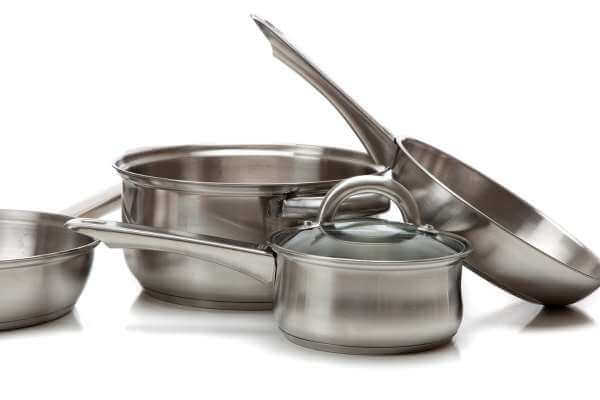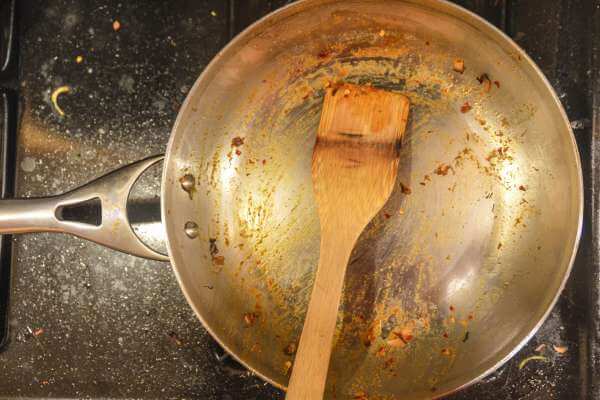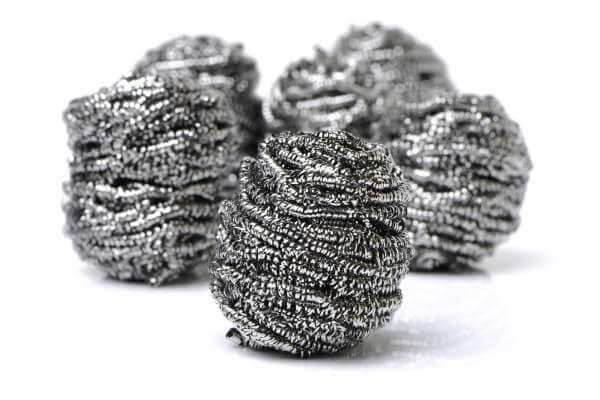Stainless steel pans are durable, versatile, and easy to maintain. They can withstand high temperatures, resist corrosion, and cook food evenly. However, they are not immune to stains, scratches, and discoloration. That’s why it’s important to know how to clean them properly and what to avoid.
One of the most common questions that people ask me is “Can You Use Steel Wool on Stainless Steel Pans”, the answer is no. Steel wool is one of the worst things you can use on stainless steel, as it can damage the surface and cause more problems than it solves.
Why You Shouldn’t Use Steel Wool on Stainless Steel

Steel wool is a bundle of thin metal fibers that are abrasive and sharp. When you rub it on stainless steel, you are essentially scraping off the protective layer of chromium oxide that gives the metal its shine and resistance to rust. This exposes the underlying iron, which can react with oxygen and moisture and form rust spots.
Steel wool can also leave behind tiny metal particles that can embed themselves on the surface of the stainless steel. These particles can rust over time and create brown or black marks that are hard to remove. They can also contaminate your food and cause health issues.
Steel wool can also create scratches and grooves on the surface of the stainless steel, which can make it look dull and uneven. These scratches can also trap dirt and bacteria, making the pan harder to clean and more prone to odors and stains.
How to Clean Stainless Steel Pans Properly

The best way to clean stainless steel pans is to use a soft cloth or sponge and a mild detergent or soap. You can also use a non-abrasive cleaner that is specially formulated for stainless steel, such as Bar Keepers Friend or Cameo. These products can remove stains, grease, and discoloration without harming the surface.
To clean your stainless steel pan, follow these steps:
- Rinse the pan with hot water to loosen any food residue.
- Apply some detergent or cleaner to the cloth or sponge and gently scrub the pan in the direction of the grain. The grain is the pattern of fine lines that you can see on the surface of the metal.
- Rinse the pan with clean water and dry it with a soft towel. Do not let it air dry, as this can cause water spots and streaks.
- If there are any stubborn stains or burnt-on food, you can soak the pan in hot water and vinegar for a few minutes, then scrub it with a nylon pad or brush. Do not use steel wool or metal brushes, as they can scratch the surface.
- If there are any rust spots or metal particles, you can remove them with a paste of baking soda and water. Apply the paste to the affected area and let it sit for a few minutes, then wipe it off with a damp cloth. Rinse and dry the pan thoroughly.
How to Prevent Stains and Scratches on Stainless Steel
To keep your stainless steel pans looking shiny and new, you should follow some simple tips to prevent stains and scratches. Here are some dos and don’ts for using and caring for your stainless steel pans:
- Do preheat your pan before adding oil or food. This will help prevent food from sticking and burning.
- Do use medium to low heat when cooking. High heat can cause discoloration and warping of the metal.
- Do use wooden, silicone, or nylon utensils when stirring or flipping food. Metal utensils can scratch the surface and damage the coating.
- Do wash your pan as soon as possible after use. Do not let food or grease sit on the surface for too long, as they can cause stains and corrosion.
- Do not use steel wool or abrasive cleaners to scrub your pan. They can scratch the surface and remove the protective layer.
- Do not use bleach or chlorine-based products to clean your pan. They can react with the metal and cause pitting and rusting.
- Do not expose your pan to extreme temperature changes. Do not plunge a hot pan into cold water or vice versa, as this can warp or crack the metal.
- Do not store your pan in a damp or humid place. Moisture can cause rust and mold growth.
Conclusion
Stainless steel pans are a great addition to any modern kitchen, but they require proper care and maintenance to keep them in good condition. One of the most important things to remember is to never use steel wool or any other abrasive material to clean them, as this can damage the surface and cause rust, stains, and scratches. Instead, use a soft cloth or sponge and a mild detergent or cleaner to gently scrub the pan in the direction of the grain. Rinse and dry the pan well after each use, and avoid exposing it to high heat, bleach, or extreme temperature changes. By following these simple tips, you can enjoy your stainless steel pans for years to come.


 Hi, my name is Debra Klein and I love modern kitchen designs! As a product reviewer, it’s my mission to help homeowners choose the right modern kitchen accessories for their homes. I want to give them the best solution possible so they can make the best decision for their needs. Thanks for reading!
Hi, my name is Debra Klein and I love modern kitchen designs! As a product reviewer, it’s my mission to help homeowners choose the right modern kitchen accessories for their homes. I want to give them the best solution possible so they can make the best decision for their needs. Thanks for reading!




